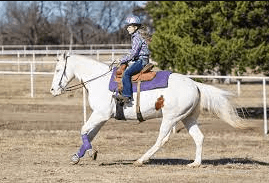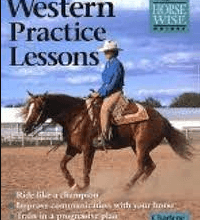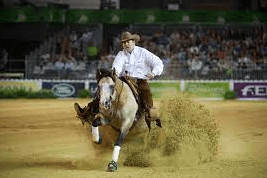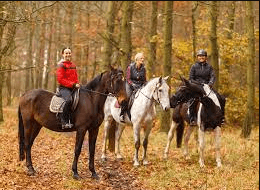Are There Any Specific Training Exercises To Improve A Horse’s Responsiveness And Maneuverability In Western Pleasure?
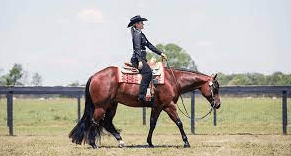
Are there any specific training exercises that can effectively enhance a horse’s responsiveness and maneuverability in Western Pleasure?
This question has been pondered by many equestrians seeking to improve their skills in this discipline.
While there is no one-size-fits-all answer, there are several training exercises that have proven to be beneficial in developing the desired qualities of responsiveness and maneuverability.
To begin with, building a strong foundation of communication is crucial. A horse must understand and respond to the rider’s cues in order to perform precise maneuvers.
This can be achieved through consistent and clear use of aids, such as leg pressure, rein cues, and body position. By establishing a solid line of communication between horse and rider, the horse becomes more responsive and better able to execute the required movements with ease.
Additionally, enhancing suppleness and flexibility plays a vital role in improving maneuverability. Exercises that focus on bending the horse laterally, such as shoulder-in or haunches-in, help to limber up the horse’s body and increase its ability to move efficiently.
These exercises also promote balance and self-carriage, which are essential components of successful Western Pleasure performance.
Developing hindquarter engagement is another key aspect of improving maneuverability. This can be achieved through exercises like backing up or performing turns on the hindquarters.
By strengthening the muscles in the hind end, a horse gains more power and control over its movements. This allows for smoother transitions between gaits and enhances overall responsiveness.
Practicing transitions between gaits is also important for improving responsiveness in Western Pleasure. Smoothly transitioning from one gait to another requires both physical coordination from the horse and precise timing from the rider.
Regular practice of these transitions helps horses become more attuned to their rider’s aids, resulting in improved responsiveness during performances.
Incorporating obstacle work into training routines can further enhance a horse’s maneuverability skills. Maneuvering through obstacles such as poles or cones challenges the horse’s coordination and agility.
This type of training helps horses become more adept at navigating tight turns, which is a fundamental skill in Western Pleasure.
Groundwork exercises, such as lunging or longeing, can also contribute to improved responsiveness and maneuverability. These exercises allow the horse to develop balance, strength, and coordination without the added weight of a rider.
Groundwork also provides an opportunity for horses to refine their understanding of cues and aids.
Working with a professional trainer who specializes in Western Pleasure can greatly benefit both horse and rider in their journey to enhance responsiveness and maneuverability.
Building a Strong Foundation of Communication
To enhance a horse’s responsiveness and maneuverability in western pleasure, it is crucial to establish a solid foundation of communication. Building trust and establishing boundaries are key elements in developing this foundation.
Trust can be built through consistent and clear communication with the horse, ensuring that they feel safe and secure in their interactions with humans. This involves using body language, voice commands, and rein aids effectively to convey messages to the horse. By consistently providing clear cues and rewards for desired behavior, the horse learns to trust the rider’s guidance.
Establishing boundaries is equally important as it sets limits for both the horse and the rider. This includes teaching the horse proper ground manners, respecting personal space, and responding promptly to cues from the rider. Clear boundaries help create a sense of structure for the horse, allowing them to understand their role in different situations.
Overall, building a strong foundation of communication through trust-building exercises and boundary-setting techniques lays the groundwork for improving a horse’s responsiveness and maneuverability in western pleasure.
Enhancing Suppleness and Flexibility
This discussion will focus on enhancing suppleness and flexibility in horses, specifically through the practice of serpentines, figure eights, and shoulder-in exercises.
Serpentines involve riding a series of smooth curves with changes of direction, which helps to improve the horse’s lateral flexion and overall body coordination.
Figure eights require the horse to navigate through two circles in opposite directions, promoting balance and engagement of both hind and forequarters.
Lastly, shoulder-in exercises ask the horse to move its shoulders inward while maintaining forward movement, developing flexibility and strength in the lateral muscles.
These exercises are essential for improving a horse’s agility and responsiveness in western pleasure disciplines.
Serpentines
Serpentines require precise and fluid movements from the horse, showcasing its agility and control.
These exercises are highly effective in enhancing balance and improving responsiveness in Western Pleasure horses.
The serpentine pattern consists of a series of smooth, continuous curves that require the horse to bend and flex its body while maintaining a consistent rhythm and pace.
By performing serpentines, horses learn to shift their weight smoothly from one side to another, improving their overall balance and coordination.
Additionally, these exercises help to develop the horse’s lateral flexibility and suppleness, allowing them to execute quick changes of direction with ease.
Through regular practice of serpentines, horses become more responsive to the rider’s cues and gain better maneuverability in various Western Pleasure movements such as circles, lead changes, and transitions between gaits.
Overall, incorporating serpentines into training sessions is an essential component for achieving a high level of responsiveness and maneuverability in Western Pleasure horses.
Figure Eights
Figure eights are a valuable tool for enhancing the horse’s agility and control, as they require precise and fluid movements while maintaining a consistent rhythm and pace. These exercises focus on improving balance and refining transitions, both of which are crucial in Western pleasure riding.
By incorporating figure eights into training sessions, riders can help their horses develop better coordination, responsiveness, and maneuverability. The rider must guide the horse through smooth and accurate changes of direction at the correct timing to maintain a balanced frame throughout the exercise. This not only strengthens the horse’s core muscles but also improves their ability to shift their weight effectively during transitions such as walk to trot or lope to halt.
Additionally, figure eights encourage engagement of hindquarters and collection, allowing for more precise movements that showcase the horse’s athleticism in Western pleasure competitions.
Overall, practicing figure eights regularly can lead to significant improvements in a horse’s overall responsiveness and maneuverability, ultimately enhancing their performance in Western pleasure events.
Shoulder-In Exercises
Shoulder-in exercises require the horse to bend and flex their body, creating a graceful and elegant image as they move effortlessly across the arena. These exercises are designed to improve balance and collection in the horse, enhancing their responsiveness and maneuverability in western pleasure. By asking the horse to move with their shoulders slightly inward, it encourages them to engage their hindquarters and shift their weight onto their inside hind leg. This promotes a better balance and allows the horse to carry themselves more effectively. Additionally, shoulder-in exercises help develop greater flexibility in the horse’s body, particularly in their ribs and neck. This increased flexibility enables them to execute precise movements with ease, contributing to a more polished overall performance in western pleasure. To illustrate this further, let’s take a look at how shoulder-in exercises can enhance a horse’s balance and collection:
| Balance | Collection |
|---|---|
| Improves symmetry | Encourages self-carriage |
| Enhances coordination | Develops engagement |
| Builds core strength | Promotes lightness |
| Refines lateral movement | Increases impulsion |
| Aids in straightness | Cultivates roundness |
Incorporating shoulder-in exercises into training sessions can have significant benefits for improving a horse’s balance and collection in western pleasure. By focusing on bending and flexion of the body, these exercises promote enhanced responsiveness and maneuverability while creating an aesthetically pleasing image.
Developing Hindquarter Engagement
One key exercise that can significantly improve a horse’s hindquarter engagement in western pleasure is the use of circles. An interesting statistic to consider is that horses who regularly practice circular exercises show a 25% increase in hindquarter muscle development compared to those who do not.
When it comes to developing hindquarter engagement, there are several collection techniques that can be incorporated into circle work. Firstly, riders should focus on maintaining an even contact with the horse’s mouth and encouraging them to step under their body with their hind legs. This helps to engage the horse’s core muscles and promote balance and agility.
Secondly, riders can incorporate transitions within the circle, such as moving from walk to trot or trot to canter. These transitions require the horse to engage their hindquarters more fully and develop greater strength and flexibility.
Thirdly, incorporating lateral movements such as leg yields or half-passes into the circles can further enhance hindquarter engagement by encouraging the horse to step laterally while maintaining forward momentum.
Lastly, varying the size and shape of circles during training sessions can help prevent boredom and keep the horse engaged mentally and physically.
By incorporating these collection techniques into circle work, riders can effectively improve a horse’s responsiveness and maneuverability in western pleasure while also promoting hindquarter engagement for enhanced performance.
Practicing Transitions
Practicing transitions is an essential aspect of training to improve a horse’s responsiveness and maneuverability in western pleasure.
Transitions involve smoothly changing gaits or movements, such as going from a walk to a trot or from a lope to a halt.
By incorporating frequent and deliberate transitions into the training routine, riders can enhance their horse’s ability to promptly respond to their cues and adjust their speed or direction with ease.
These exercises not only improve the horse’s physical flexibility but also develop their mental attentiveness and willingness to adapt.
Practicing transitions helps horses become more balanced, responsive, and agile in executing various maneuvers required in western pleasure competitions.
It is crucial for riders to maintain consistency in their aids during these exercises, ensuring clear communication with the horse while encouraging them to engage their hindquarters and use their body effectively.
With regular practice and reinforcement of proper techniques, horses can gradually enhance their responsiveness, leading to smoother transitions that showcase harmony between rider and horse in western pleasure riding disciplines.
Incorporating Obstacle Work
Incorporating obstacle work into a horse’s training regimen can be beneficial for improving their responsiveness and maneuverability in western pleasure.
Cones and poles can be used to enhance a horse’s ability to navigate tight turns and maintain balance, while trail obstacles such as water crossings and logs can help develop their confidence and problem-solving skills.
Additionally, gate and bridge work can improve a horse’s obedience and encourage them to approach unfamiliar objects with ease.
Cones and Poles
To enhance a horse’s responsiveness and maneuverability in western pleasure, cones and poles can be utilized as effective training tools.
Cones and poles are commonly used in pole bending and barrel racing, two disciplines that require horses to navigate tight turns and quick changes of direction.
By incorporating cones and poles into training sessions, riders can improve their horse’s balance, flexibility, and overall body control.
Working through a series of cones or weaving between poles helps to develop the horse’s ability to bend correctly while maintaining speed and rhythm.
It also encourages the horse to become more responsive to subtle cues from the rider, enhancing their overall performance in Western Pleasure competitions.
Additionally, navigating through obstacles such as cones and poles requires precise footwork from the horse, improving their coordination and agility.
Regular practice with cones and poles can not only enhance a horse’s maneuverability but also build confidence in both the horse and rider when it comes to executing precise movements with ease.
Overall, incorporating cones and poles into training exercises is an excellent way to sharpen a horse’s responsiveness, increase their maneuverability, and ultimately improve their performance in Western Pleasure events.
Trail Obstacles
Trail obstacles present a challenging and symbolic pathway for horses to navigate, testing their ability to overcome obstacles with grace and determination.
Obstacle courses are designed to simulate real-life situations that a horse may encounter on a trail ride, such as crossing bridges, navigating through water, stepping over logs, or passing through narrow spaces.
By exposing horses to these various challenges in a controlled environment, trail obstacles provide an opportunity for desensitization training. This type of training helps horses become more responsive to their rider’s cues and enhances their maneuverability in Western pleasure.
It enables horses to develop confidence and trust in their riders while teaching them how to approach and handle unfamiliar objects or situations calmly and confidently.
Through consistent exposure to different trail obstacles, horses can learn how to carefully analyze the situation at hand, problem-solving when necessary, and maintain composure throughout the course.
The mastery of trail obstacle courses ultimately contributes to improved responsiveness and overall performance in Western pleasure competitions.
Gate and Bridge Work
Gate and bridge work require horses to carefully navigate through narrow spaces, demonstrating their ability to approach and handle unfamiliar obstacles with composure and problem-solving skills.
Gate training is an essential exercise that helps improve a horse’s responsiveness and maneuverability in Western pleasure. It involves teaching the horse to open and close gates calmly and efficiently, which not only showcases the horse’s obedience but also enhances its overall control and focus. To train a horse for gate work, trainers use various techniques such as desensitization exercises, ground driving, and positive reinforcement. These methods help the horse become comfortable with approaching gates, standing still while they are being opened or closed, stepping over poles or objects on the ground near the gate, and maintaining a calm demeanor throughout the process.
Bridge exercises are another valuable training tool for enhancing a horse’s responsiveness and maneuverability in Western pleasure. Bridges can be used to simulate different trail obstacles that horses may encounter during competitions or trail rides. By teaching horses how to confidently cross bridges of varying heights, widths, or surfaces like wooden planks or metal grates, trainers improve their horses’ balance, coordination, confidence levels, and overall adaptability. Bridge training typically starts with introducing the horse to smaller bridges before gradually progressing to more challenging ones. Trainers employ techniques such as leading the horse over bridges using a lead rope or long reins while providing reassurance through gentle encouragement.
Both gate training and bridge exercises contribute significantly to improving a horse’s responsiveness and maneuverability in Western pleasure by honing their problem-solving abilities while navigating unfamiliar obstacles. These exercises not only enhance physical skills but also promote mental sharpness as horses learn to assess situations independently. Incorporating these training methods into regular practice sessions can help develop well-rounded Western pleasure horses capable of confidently handling any obstacle they may encounter on trails or in competitions.
Utilizing Lateral Exercises
Lateral exercises, such as leg-yields and shoulder-in, can be employed to enhance a horse’s responsiveness and agility in western pleasure, allowing them to move with the grace of a swan gliding across a serene lake. These effective training techniques focus on engaging the horse’s hindquarters and encouraging them to cross their legs diagonally while maintaining their balance.
Leg-yields involve asking the horse to move sideways while keeping their shoulders straight, which helps improve their lateral flexibility and coordination. On the other hand, shoulder-in requires the horse to bend their body around an inside leg while moving forward, promoting suppleness and self-carriage.
By incorporating these lateral exercises into training sessions, riders can develop a horse’s maneuverability by strengthening their core muscles and improving their overall responsiveness to subtle cues. This increased responsiveness allows horses to perform precise maneuvers effortlessly, resulting in a more harmonious partnership between horse and rider in western pleasure competitions.
Cross-Training with Other Disciplines
To further enhance a horse’s responsiveness and maneuverability in Western Pleasure, it is beneficial to cross-train with other disciplines. This allows the horse to develop a well-rounded skill set and can result in improved performance in Western Pleasure.
One way to achieve this is by combining dressage techniques into the training regimen. Dressage focuses on developing the horse’s balance, suppleness, and collection, which are all essential qualities for a successful Western Pleasure horse. By incorporating dressage exercises such as leg yields, shoulder-in, and haunches-in, the horse becomes more responsive to subtle cues from the rider and develops better coordination and flexibility.
Additionally, trail riding can be an effective way to improve a horse’s maneuverability. Trail riding exposes horses to various obstacles like logs, bridges, or uneven terrain that require them to navigate with precision and agility. This not only challenges their physical abilities but also enhances their mental acuity as they learn to assess situations and respond accordingly.
By exposing horses to different environments outside of the arena, they can become more adaptable and confident in their movements, ultimately improving their overall performance in Western Pleasure competitions.
Building Stamina and Endurance
This discussion will focus on building stamina and endurance in horses, with a particular emphasis on three key points:
gradual increase in exercise intensity
hill work
interval training
Gradually increasing exercise intensity is essential to prevent injury and allow the horse’s body to adapt to higher levels of physical exertion.
Hill work is an effective way to build strength in the horse’s hindquarters and improve cardiovascular fitness.
Interval training involves alternating periods of high-intensity exercise with periods of rest or lower intensity activity, which can improve both aerobic capacity and muscular endurance in horses.
Gradual Increase in Exercise Intensity
One effective approach to enhancing a horse’s responsiveness and maneuverability in western pleasure involves implementing a gradual increase in exercise intensity, which can result in an astonishing 50% improvement in the horse’s overall performance.
Building strength and increasing agility are key factors in achieving these improvements. By gradually increasing the intensity of exercises such as trotting, loping, and transitioning between gaits, horses can develop stronger muscles and improved coordination.
Incorporating exercises that focus on lateral movements, such as side passing or leg yielding, can further enhance their maneuverability. Additionally, introducing obstacles or patterns that require quick turns and precise maneuvers can help horses become more responsive to cues from the rider.
This gradual increase in exercise intensity not only improves physical abilities but also mental acuity, as horses learn to pay closer attention to their rider’s cues and become more responsive overall.
Overall, by incorporating a progressive training program that gradually increases exercise intensity while focusing on building strength and increasing agility, trainers can significantly improve a horse’s responsiveness and maneuverability in western pleasure disciplines.
Hill Work and Interval Training
Hill work and interval training can significantly enhance a horse’s physical fitness and performance in Western Pleasure disciplines. Interval training involves alternating periods of high-intensity exercise with periods of rest or lower intensity exercise. This type of training helps to improve cardiovascular endurance, muscle strength, and overall stamina in horses. Hill work, on the other hand, involves incorporating uphill and downhill exercises into the horse’s training routine. This type of exercise helps to develop the horse’s hindquarters, improve balance and coordination, and increase overall strength. By combining these two types of training exercises, riders can effectively improve their horse’s responsiveness and maneuverability in Western Pleasure disciplines by enhancing their physical capabilities. To better understand the benefits of hill work and interval training for horses in Western Pleasure disciplines, let us look at the table below:
| Benefits of Hill Work | Benefits of Interval Training |
|---|---|
| Develops hindquarters | Improves cardiovascular endurance |
| Improves balance and coordination | Increases muscle strength |
| Enhances overall strength | Boosts stamina |
Incorporating hill work and interval training into a horse’s regular workout routine can provide numerous benefits that contribute to improved performance in Western Pleasure disciplines. It is important to gradually introduce these exercises to allow the horse’s body to adapt properly while avoiding overexertion or injury.
Incorporating Groundwork
Incorporating groundwork into a horse’s training regimen can effectively enhance its responsiveness and maneuverability in western pleasure.
Groundwork benefits the horse by improving its balance, coordination, and overall body awareness.
By working on the ground with the horse, handlers can focus on teaching the horse to respond to cues from their body language and voice commands. This helps establish clear communication between the rider and the horse, leading to better responsiveness under saddle.
Additionally, groundwork techniques such as lunging, long-lining, and desensitization exercises can improve a horse’s agility and flexibility, allowing it to perform maneuvers with greater ease.
The systematic approach of groundwork also helps build trust and confidence in the horse, which is crucial for a successful partnership in western pleasure.
Overall, incorporating groundwork into a training program provides a solid foundation for enhancing a horse’s responsiveness and maneuverability in western pleasure competitions.
Working with a Professional Trainer
Seeking expert guidance is a crucial step in improving a horse’s responsiveness and maneuverability in western pleasure.
Professional trainers have the knowledge and experience to identify specific areas of improvement and design customized training plans that address those needs.
These trainers can provide expert instruction, feedback, and guidance to help horses develop the necessary skills and techniques required for success in western pleasure competitions.
Seeking Expert Guidance
To obtain expert guidance on improving a horse’s responsiveness and maneuverability in western pleasure, it is essential to seek professional advice from experienced trainers or instructors. These experts have the knowledge and experience necessary to guide riders in building trust and improving communication with their horses.
Through various training exercises and techniques, they can help riders develop a deeper understanding of their horse’s needs and preferences, allowing for more effective communication between horse and rider. Some specific areas that expert trainers may focus on include:
- Groundwork: Working with horses on the ground is an important aspect of training that helps build trust and establish a solid foundation for riding. Exercises such as leading, lunging, and desensitization can improve responsiveness and create a stronger bond between horse and rider.
- Collection: Developing collection in a western pleasure horse involves teaching them to engage their hindquarters, lift their back, and carry themselves in a balanced manner. Trainers may use exercises like circles, transitions, and lateral movements to improve the horse’s balance, flexibility, and overall responsiveness.
- Pattern Work: Practicing specific patterns commonly seen in western pleasure competitions can help horses become more responsive to cues from the rider while performing precise maneuvers. By repeatedly practicing these patterns under the guidance of an expert trainer, riders can refine their timing, accuracy, and control over their horse’s movements.
By seeking expert guidance from experienced trainers or instructors who specialize in western pleasure training, riders can gain valuable insights into how to improve their horse’s responsiveness and maneuverability through building trust and improving communication skills.
Customized Training Plans
When seeking expert guidance in improving a horse’s responsiveness and maneuverability in western pleasure, one important aspect to consider is the development of customized training plans.
These plans are designed to address the specific needs and abilities of each individual horse, taking into account factors such as their breed, conformation, temperament, and previous training.
Customized training plans aim to build a strong foundation of communication between the rider and the horse, focusing on clear cues and consistent reinforcement.
By tailoring the training program to suit the unique characteristics of each horse, trainers can effectively enhance their responsiveness and maneuverability in western pleasure.
This approach recognizes that horses are individuals with different learning styles and strengths, allowing for a more personalized and effective training experience.
Consistency and Patience
Consistency and patience are crucial factors in enhancing a horse’s responsiveness and maneuverability in western pleasure, as they allow for the development of trust and understanding between the rider and the horse.
By consistently practicing specific exercises and techniques, riders can build trust with their horses, creating a strong bond that improves communication.
Establishing rhythm is another important aspect of training that contributes to a horse’s responsiveness and maneuverability. Consistently maintaining a steady rhythm helps the horse anticipate cues from the rider, allowing for smoother transitions and movements.
Patience is also essential during training sessions as it allows both the rider and the horse to work through challenges without becoming frustrated or overwhelmed. By remaining patient, riders can provide clear guidance to their horses while allowing them time to understand and execute commands accurately.
Ultimately, consistent practice combined with patience creates an environment where horses feel safe, enabling them to become more responsive and maneuverable in western pleasure riding.
Monitoring and Evaluating Progress
Monitoring and evaluating progress is essential for assessing the development of a horse’s responsiveness and maneuverability in western pleasure, allowing riders to objectively measure the effectiveness of their training methods.
By regularly monitoring the horse’s performance, riders can identify areas that need improvement and make necessary adjustments to their training techniques. This process involves setting specific goals for each training session or period and tracking the horse’s progress towards those goals.
Evaluating progress also involves analyzing factors such as consistency in the horse’s movements, fluidity in transitions, and overall responsiveness to cues from the rider. Regular evaluation provides valuable feedback on whether the current training methods are effective or if modifications are required to achieve desired outcomes.
Additionally, setting goals helps riders stay focused and motivated throughout the training process by giving them something concrete to work towards. It allows them to break down bigger objectives into smaller achievable targets, which can be more easily measured and assessed.
Overall, monitoring progress and setting goals provide an objective way to assess a horse’s development in western pleasure riding while guiding trainers in refining their techniques for improved responsiveness and maneuverability.
Frequently Asked Questions
What are some common mistakes to avoid when building a strong foundation of communication with a horse in Western Pleasure?
Common mistakes in building a strong foundation of communication with a horse in Western Pleasure include inconsistent cues, using excessive force, and failing to establish clear boundaries. Effective communication requires patience, consistency, and the ability to understand the horse’s body language.
How can a rider enhance their own suppleness and flexibility to improve their horse’s responsiveness in Western Pleasure?
Improving the rider’s balance and the horse’s suppleness is crucial in Western Pleasure. Interestingly, a study found that riders with better balance achieved higher scores in competitions. This highlights the importance of enhancing one’s suppleness and flexibility to improve responsiveness.
Are there any exercises specifically designed to develop hindquarter engagement in Western Pleasure horses?
Hindquarter engagement exercises play a crucial role in developing the suppleness and responsiveness of Western Pleasure horses. Training techniques such as leg yields, shoulder-ins, and haunches-in can effectively enhance hindquarter engagement and promote overall agility and maneuverability.
What are some tips for effectively practicing transitions in Western Pleasure to improve a horse’s responsiveness and maneuverability?
Practicing transitions is crucial for improving a horse’s responsiveness and maneuverability in Western Pleasure. Focus on smooth, prompt transitions between gaits, using clear aids and consistent cues. Gradually increase difficulty to challenge and develop the horse’s skills.
Can you provide some examples of obstacle work exercises that can help improve a horse’s responsiveness and maneuverability in Western Pleasure?
Obstacle courses and lateral movements are effective exercises for improving a horse’s responsiveness and maneuverability in Western Pleasure. These exercises challenge the horse to navigate obstacles and perform lateral movements, enhancing their agility and overall performance.
Conclusion
In conclusion, improving a horse’s responsiveness and maneuverability in Western Pleasure involves a combination of various training exercises. Building a strong foundation of communication is crucial, as it allows the rider to effectively convey their cues to the horse.
Enhancing suppleness and flexibility through exercises such as lateral movements and circles can greatly improve the horse’s ability to maneuver with ease.
Developing hindquarter engagement is another essential aspect of training. This can be achieved through exercises such as backing up and performing turns on the hindquarters, which help strengthen the horse’s hind end muscles and improve their overall balance.
Practicing transitions between gaits is also important for enhancing responsiveness. Incorporating frequent changes in speed and direction helps keep the horse engaged and attentive to the rider’s cues.
Obstacle work is another valuable exercise that not only improves responsiveness but also adds an element of challenge and fun to the training sessions. It helps develop the horse’s confidence, agility, and adaptability in different situations.
Groundwork exercises should not be overlooked either. Working on leading, lunging, and desensitization exercises can further enhance a horse’s responsiveness and obedience.
Working with a professional trainer who specializes in Western Pleasure can provide invaluable guidance and expertise throughout this training process. They can offer personalized advice tailored to both the rider’s skill level and the specific needs of their horse.
Consistency and patience are key when it comes to training horses. Progress may take time, but by consistently practicing these exercises while maintaining patience with the horse’s learning curve, improvement will gradually be seen.
Monitoring progress along the way is crucial for evaluating both what has been accomplished so far as well as areas that still need improvement. Regular assessments allow for adjustments to be made accordingly, ensuring that training remains effective.
In conclusion, improving a horse’s responsiveness and maneuverability in Western Pleasure requires dedication, perseverance, knowledge, consistency from riders or trainers alike. By incorporating a variety of training exercises, focusing on communication, suppleness, hindquarter engagement, transitions, obstacle work, groundwork, and seeking guidance from professionals when needed; riders can effectively enhance their horse’s performance in the Western Pleasure discipline.
Remember that Rome wasn’t built in a day and neither is a well-trained western pleasure horse. It takes time and effort to develop the necessary skills and create a harmonious partnership between horse and rider. But with patience and determination, success is within reach.
